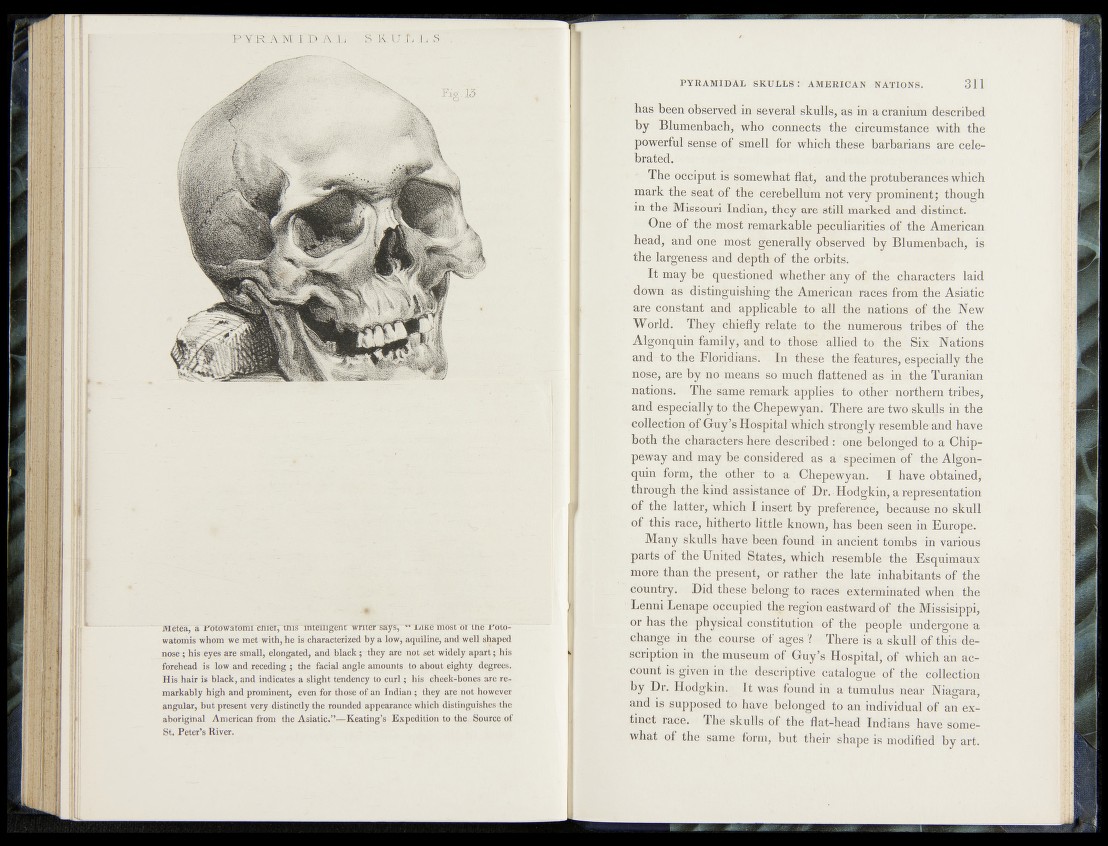
Meiea, a Fotowatocn intter^ans imemgsmr writer says;- "XiiKeTHCst or me Foto-
watomis whom we met with, he is characterized by a low, aquiline, and well shaped
nose; hisieyes are small, elongated, and black; they are not set widely apart; his
forehead is low and receding; the facial angle amounts to about eighty degrees.
His hair is black, and indicates a slight tendency to curl; his cheek-bones are remarkably
high and prominent, even for those of an Indian; they a?e not however
angular, but present very distinctly the rounded appearance which distinguishes the
aboriginal American from the Asiatic.’’—Keating’s Expedition to the- Source of
St. Peter’s River.
PYRAMIDAL SKULLS: AMERICAN NATIONS. 311
has been observed m# Several skulls, as in a cranium described
by Blumenbach, who ^connects the circumstance with the
powerful senSèrof smell forwhich these barbarians are celebrated.
* The (^ f^ u t ilr^omewhat flat, and the protuberances which
mark the seat"of th{e>.cpre|)e^um,,TiQ't Very- prominent; though
in the'Missouri Indian", they? are still marked and distinct.
One of the. most remarkable peculiaritie&iof the American
head, and one Absfjl'generally observed by Blumenbach, is
the- largeness and depth of the orbits. ,,
ft may be questiöheu whether.any of the characters laid
down as distinguishing the American races from? th e Asiatic
are constant1' and applicable to all;thje ’nations,, of the New
World. They chiefly relatedtoithe numerous tribes,of the
■Aflgoh’lfuin family; and" to s those Allied to tHe^SiW Nations
and-to the Florid iansf\ In these the ffejatUrës/ es^ëcaal|yj'khe
^#e* are by no means’ somiuch flattened* as in the Turanian
nations. The same remark applies’' to other-northern tribes,
,and Especially to the Chepewyan.’ There are two skulls in the
collection of Guy ’s Hospital which strongly resemble and havé?
both the characters here described: one belonged to a Chip-
peway and may foe* considered/ as d 'speèimëthof the’Algon-
qmn form, the other to a Chepèwyan. I hare obtained,
through the kind assistance of Dr. Hodgkin, a representation
of the latter^ which I insert by preference, because aio' Skull
of this, race, hitherto little known, has been seen in Europe.
Many skulls have been, found in ancient tombs in various
parts of the United States,-which resemble the Esquimaux
more than the present, or rather the late inhabitants of the
country. Did these bekrhg-to races exterminated when , the
Lenni Lenape occupied th.e region eastward of the Missisippi,
or has the physical constitution of- the people undergone a
change in the course-of ages ? There is a skull of this description
in the museum of Guy’s Hospital, of which an account
is, given ia the descriptive catalogue of the collection
by Dr. Hodgkin. It was found in a tumulus near Niagara,
and is supposed to have ^belonged to an individual of an extinct
race. The skulls of the flat-head Indians havte somewhat
of the same form, but their shape is modified by art.
w m m R